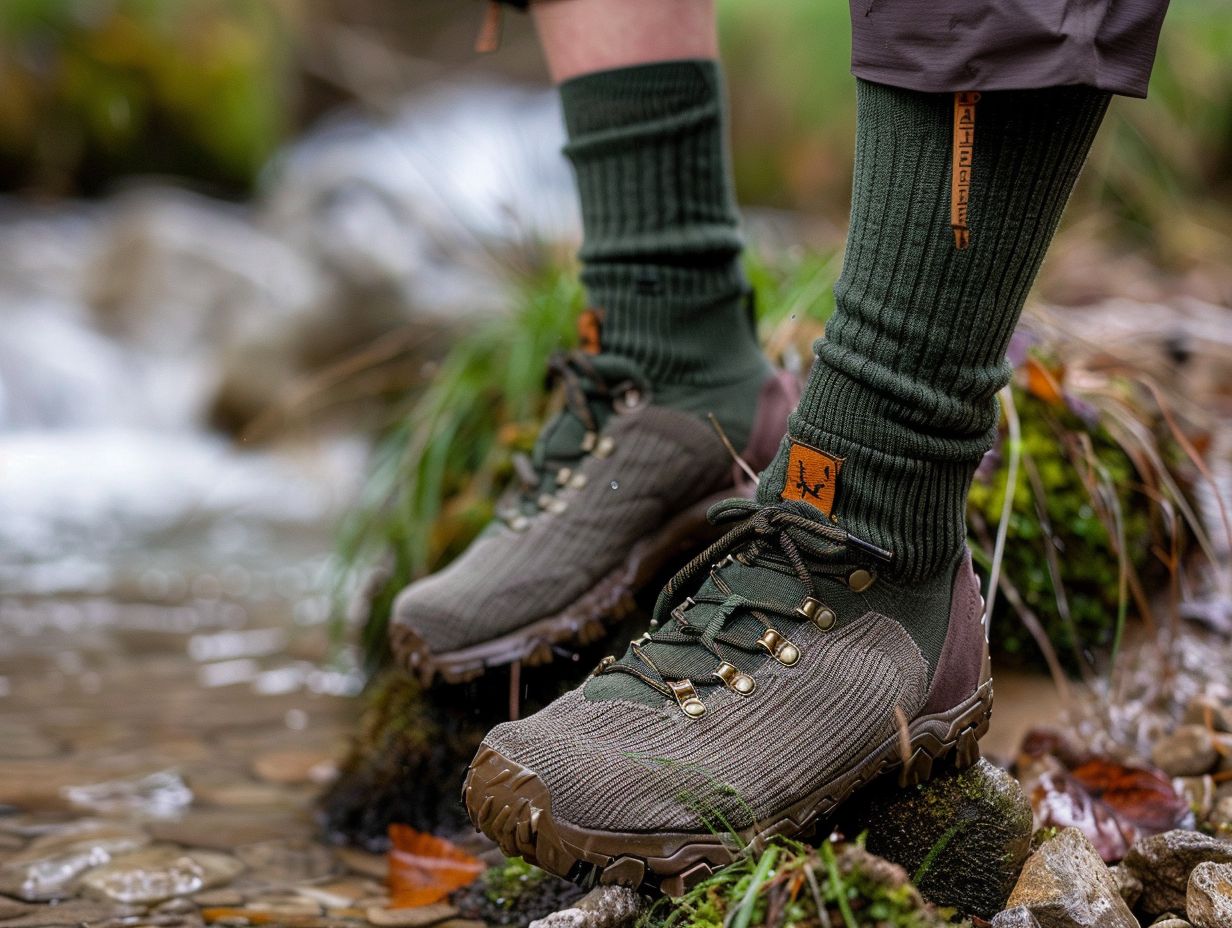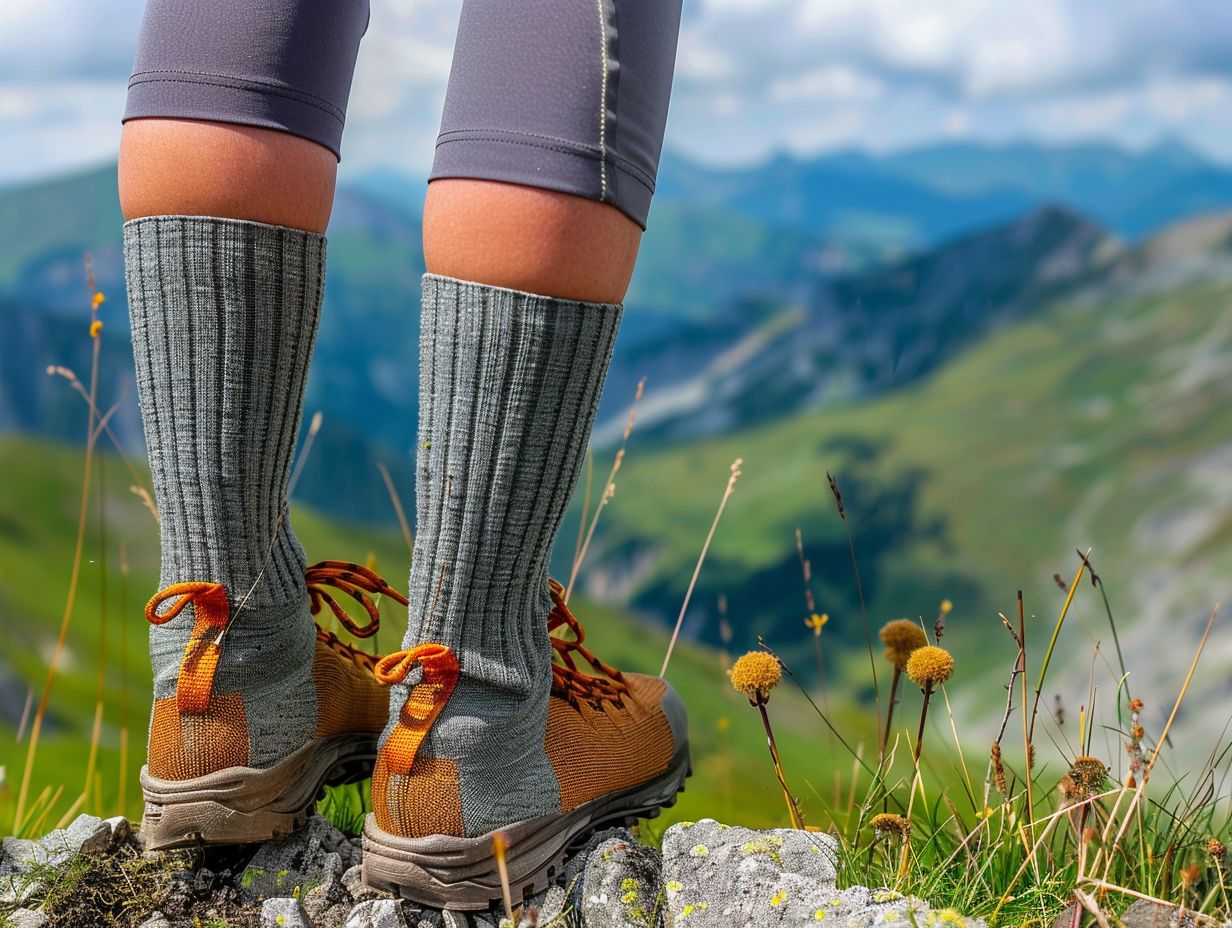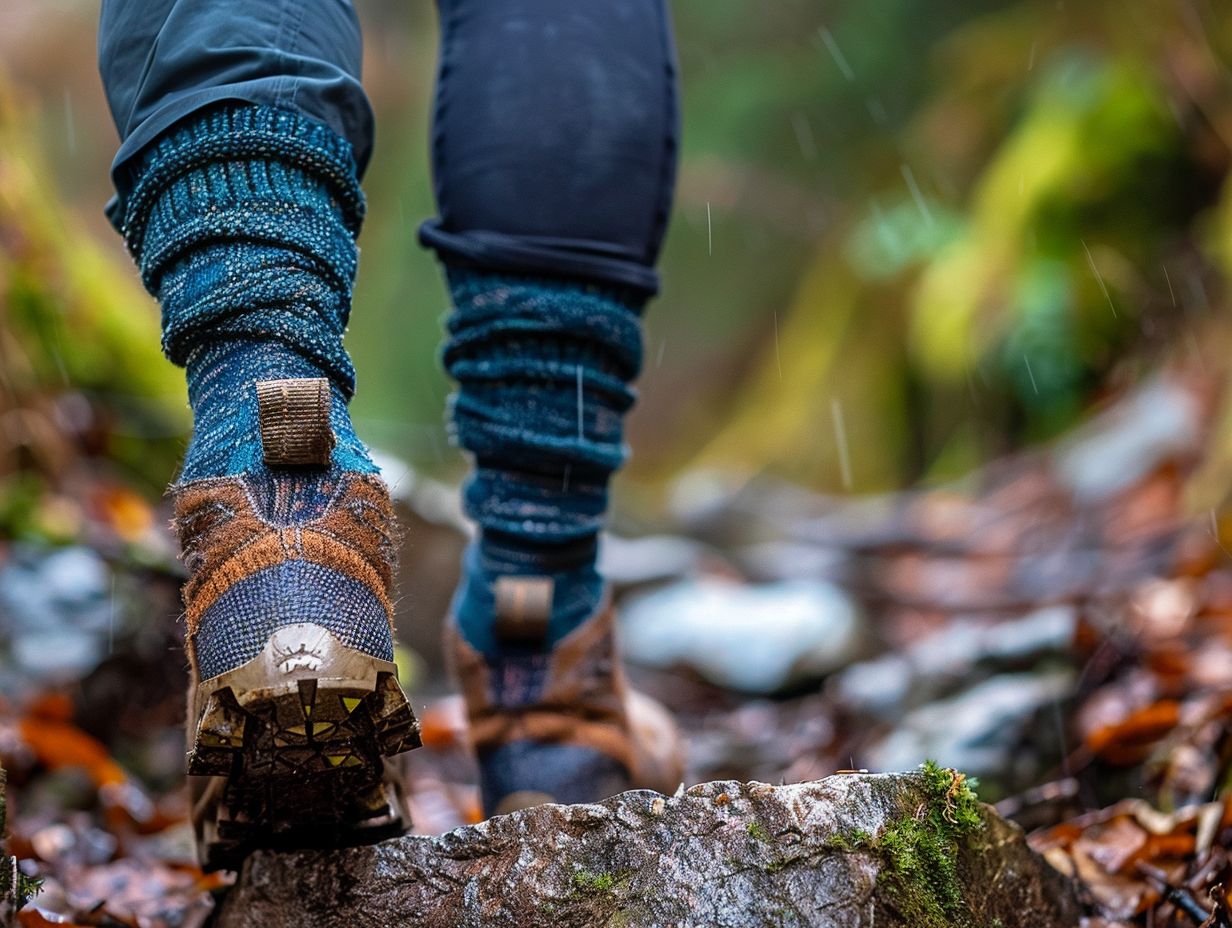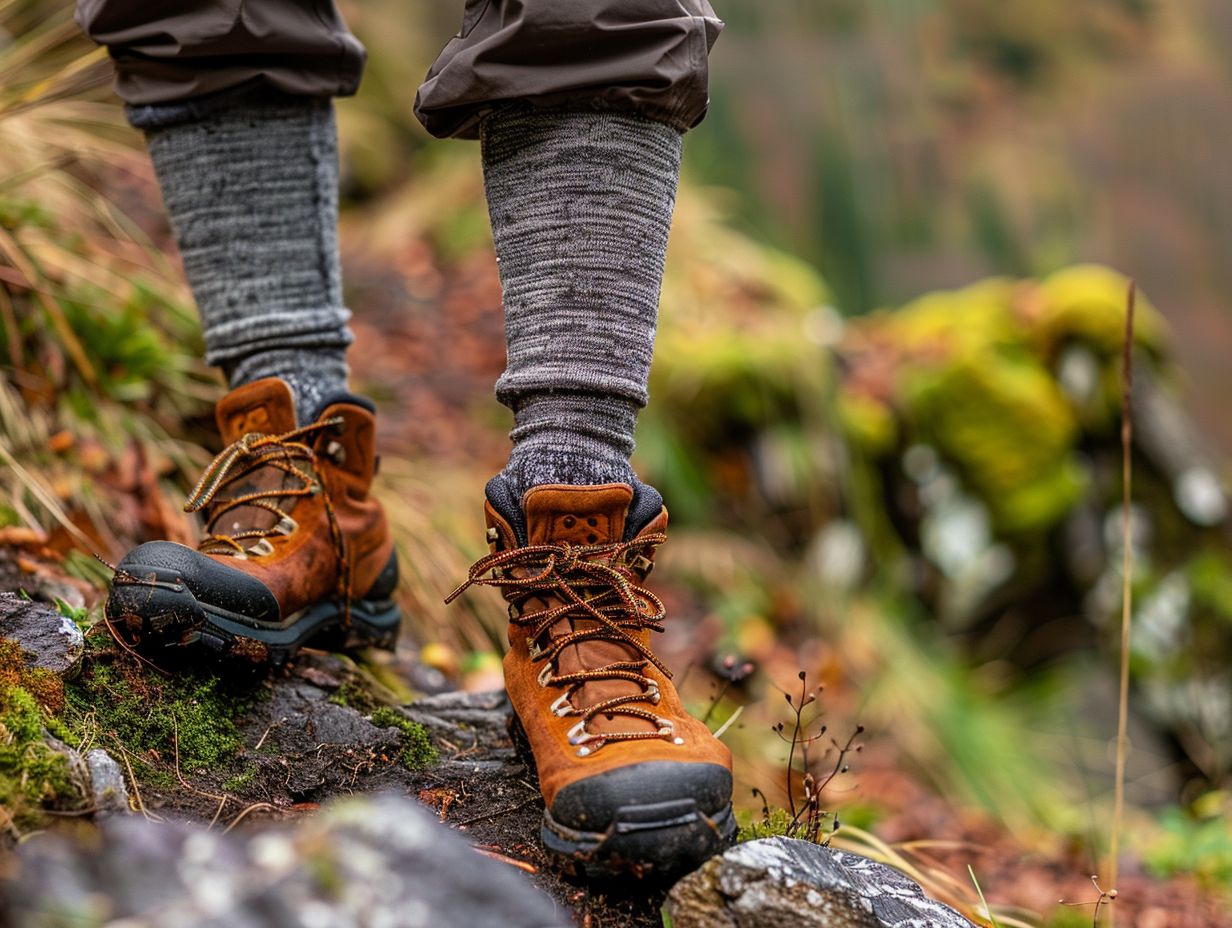Are you tired of dealing with painful blisters while hiking? If so, the top 10 hiking socks discussed in this article can help prevent blisters and offer added comfort and support during your outdoor excursions.
The article covers various types of socks, from merino wool to compression socks, and highlights the best materials and features to consider when selecting hiking socks. Be sure to pay attention to details such as choosing the correct size, proper sock care, and strategies for blister prevention while you are out hitting the trails.
Key Takeaways:

- Choose merino wool socks for natural moisture-wicking and temperature regulation to prevent blisters during hikes.
- Synthetic socks with moisture-wicking properties are great for preventing blisters by keeping feet dry and reducing friction.
- Invest in cushioned socks for added comfort and protection against blisters while hiking on uneven and rough terrain.
1. Merino Wool Socks
Merino wool socks are esteemed for their exceptional comfort, cushioning, and moisture-wicking properties, making them a favoured choice among hikers seeking top-tier performance.
The intrinsic qualities of Merino wool designate it as an optimal material for outdoor enthusiasts like yourself. Its temperature-regulating capabilities guarantee that your feet remain warm in chilly climates and cool in hotter conditions, ensuring continuous comfort during your hikes.
The enduring nature of Merino wool socks enables them to endure the demands of regular wear and laundering without sacrificing their shape or softness.
The gentle fibres delicately envelop your feet, reducing friction and preventing blisters—essential for individuals embarking on lengthy, demanding walks. The innate moisture management of Merino wool aids in keeping your feet dry and odourless, allowing you to focus on relishing the great outdoors without any discomfort.
2. Synthetic Socks with Moisture-Wicking Properties
Synthetic socks engineered with moisture-wicking properties are designed to keep your feet dry and comfortable, reducing friction and lowering the risk of blisters while hiking.
These advanced materials, such as polyester and nylon, efficiently draw sweat away from your skin, allowing it to evaporate quickly, thereby preventing the build-up of moisture that can lead to hot spots and discomfort.
By maintaining a dry environment around your feet, these synthetic socks also promote foot hygiene, reducing the chances of bacterial growth and odours. Their ability to efficiently manage moisture helps in preventing blisters, making them ideal for tackling challenging terrains during outdoor activities.
3. Cushioned Socks for Added Comfort
Padded socks provide increased comfort and padding, enhancing the fit inside your hiking boots whilst offering extra support during extended hikes. The cushioning technology utilised in these socks is essential for decreasing foot fatigue as it absorbs the impact of each step, enabling you to have a more enjoyable hiking excursion.
With an additional layer of softness and support, padded socks work to reduce pressure points that may arise from prolonged walking or hiking, ensuring that your feet are both comfortable and safeguarded throughout your outdoor activities.
4. Compression Socks for Improved Blood Flow

Compression socks apply gentle pressure to improve blood circulation in your feet, aiding in reducing fatigue and enhancing endurance throughout your hiking journey.
The compression provided by these specialised socks helps to prevent the pooling of blood in your lower limbs, which can often lead to swelling, muscle soreness, and cramp. By encouraging efficient blood flow back towards your heart, compression socks play a vital role in minimising discomfort and strain during long hikes.
The enhanced circulation promoted by these socks facilitates faster recovery after strenuous physical activity, allowing you to maintain foot health and continue enjoying your outdoor adventures with reduced risk of injury.
5. Toe-Separating Socks for Reduced Friction
Toe-separating socks are crafted with the purpose of minimising friction between your toes, thereby preventing blisters and discomfort, particularly when you are wearing snug hiking shoes in challenging terrains.
By establishing a tangible barrier between each toe, these pioneering socks not only decrease the likelihood of painful blisters and skin abrasions but also encourage proper toe alignment. This alignment can lead to enhancements in overall foot posture and a reduction in foot strain, making these socks a valuable inclusion in your foot care regimen.
The separation of your toes facilitates improved air circulation, which assists in maintaining optimal foot hygiene by averting moisture buildup and potential fungal infections.
6. Liner Socks for Added Protection
Liner socks serve as a preventive layer between your skin and outer socks, providing an additional protective barrier against blisters and increasing comfort during hiking expeditions.
Creating a dual-layer system, liner socks help decrease friction by enabling the inner and outer layers to move against each other, rather than causing friction against your skin. This reduction in friction is critical in blister prevention, as it minimises the rubbing that commonly leads to painful sores.
Liner socks are particularly effective in managing moisture by wicking sweat away from your skin, keeping your feet dry and decreasing the likelihood of friction-related problems. This enhanced moisture control not only boosts comfort but also aids in regulating temperature within your footwear, leading to a more enjoyable hiking experience overall.
7. Bamboo Socks for Breathability
Bamboo socks are highly valued for their exceptional breathability and moisture-wicking capabilities, which help keep your feet cool and dry, even in hot and humid conditions during hikes.
The natural fibres of bamboo fabric make it an excellent choice for outdoor enthusiasts due to its ability to regulate foot temperature, preventing overheating while ensuring comfort.
The porous structure of bamboo fibres allows for improved air circulation, reducing the chances of bacteria growth and unpleasant odours, thus keeping your feet fresh and rejuvenated all day long.
Whether you are navigating rugged terrain or carrying out daily tasks, bamboo socks offer a soft and comfortable fit while efficiently absorbing sweat, making them a dependable companion for individuals with active lifestyles.
8. Anti-Blister Socks with Specialised Padding

You can benefit from using anti-blister socks, which are designed with specialised padding in key areas such as the heel and toe. This targeted protection helps to prevent friction and pressure points, ensuring a hiking experience free from blisters.
These socks are intricately crafted with reinforced padding zones strategically placed to absorb impact and reduce friction, two common culprits behind blisters during outdoor activities.
By incorporating these design elements, anti-blister socks not only prevent discomfort but also support foot health on challenging trails by minimising the risk of developing painful blisters.
The reinforced padding acts as a protective barrier between your foot and the shoe, creating a shield that enhances overall comfort and allows you to focus on your adventure without concerns about foot problems.
9. Socks with Arch Support for Added Stability
When you wear socks with arch support, you experience enhanced stability and reduced foot fatigue while traversing uneven hiking trails. These specialised socks offer optimal comfort and support for your extended outdoor adventures.
The arch support feature in these socks plays a critical role in maintaining proper foot alignment, which is vital for minimising strain on your feet, ankles, and legs during long hikes.
By providing targeted support to the arch of your foot, these socks help distribute weight more evenly, thereby preventing discomfort that may result from excessive pressure on specific areas.
This attribute not only improves balance and stability on challenging terrain but also contributes to better overall performance and endurance, making them a valuable asset for any avid hiker.
10. Wool and Silk Blend Socks for Warmth and Softness
When considering socks for cold-weather hikes, wool and silk blend socks offer a luxurious combination of warmth and softness that can enhance your outdoor experience. The unique blend of wool and silk fibres in these socks provides exceptional warmth whilst also offering excellent moisture management capabilities.
This combination helps keep your feet dry and comfortable, even during extended outdoor activities. The natural properties of wool assist in regulating foot temperature, ensuring your feet stay cosy without overheating.
Additionally, the soft touch of silk against the skin adds a touch of luxury and helps prevent irritation, making these socks an ideal choice for all-day wear during your outdoor adventures.
What Causes Blisters When Hiking?
Blisters when hiking are primarily caused by the combination of friction, moisture, pressure, and heat, resulting in discomfort and skin irritation during outdoor treks. Repetitive rubbing plays a crucial role in blister development by increasing friction between the foot and the shoe, causing the skin layers to separate.
The presence of trapped moisture intensifies this problem by softening the skin and making it more vulnerable to damage caused by friction.
Applying excessive force to specific areas of the foot can create hot spots that quickly evolve into blisters. The heightened foot temperature during hiking activities contributes to the dilation of blood vessels, which can further exacerbate blister formation. These factors not only affect foot health but also diminish the overall enjoyment of hiking excursions.
How Can the Right Socks Help Prevent Blisters?

Regarding blister prevention during hiking expeditions, selecting the right socks is essential. To minimise friction and maintain comfort, it is crucial to choose socks that offer moisture management, cushioning, and support.
Opt for socks with moisture-wicking properties to keep your feet dry by drawing sweat away from the skin, reducing the risk of blisters due to prolonged moisture exposure.
Look for socks with padding in key areas like the heel and toe to provide additional cushioning and reduce impact and friction during extended hikes.
Ensure a proper fit, as socks that are either too loose or too tight can create friction points that lead to blisters. By carefully selecting socks with these features, hikers can enhance foot protection and improve their overall hiking experience.
What Materials Should Hiking Socks Be Made Of?
When selecting hiking socks, you should opt for those made from durable materials such as Merino wool or Smartwool, as these are well-known for their longevity, moisture-wicking capabilities, and natural comfort, catering to the needs of outdoor enthusiasts. These premium materials bring forth a myriad of advantages that elevate the hiking experience.
Merino wool, in particular, stands out for its exceptional moisture control, effectively removing sweat to maintain dryness and comfort during lengthy excursions. Both Merino wool and Smartwool showcase inherent antimicrobial qualities, rendering them resistant to odours even after prolonged wear, which is essential for multi-day journeys.
Their remarkable durability is another key attribute, ensuring that your hiking socks endure through numerous adventures, consistently delivering performance and comfort.
What Features Should I Look for in Hiking Socks?
When selecting hiking socks, you should prioritize features such as cushioning for impact absorption, a proper fit to prevent slippage, and moisture-wicking properties to maintain dry and comfortable feet while on the trails.
Arch support is another critical aspect to consider when choosing hiking socks. Sufficient arch support helps evenly distribute pressure across the foot, reducing fatigue and discomfort, particularly during extended treks.
Seamless toes are essential to prevent rubbing and blisters, ensuring a comfortable and friction-free experience. Reinforced heels offer durability and protection against abrasion in high-wear areas.
Breathability in hiking socks allows for adequate ventilation, preventing overheating and moisture buildup, which can lead to blisters and hot spots.
How Do I Choose the Right Size and Fit for Hiking Socks?
When selecting the right size and fit for your hiking socks, it is vital to prioritize optimal comfort and performance. Factors such as the sock model, weight, and the conditions in which you will be hiking all play a crucial role in this decision-making process.
When determining the appropriate sock size based on your shoe size, it is imperative to refer to the sizing chart provided by the sock manufacturer. This will help ensure a fit that is snug yet not overly constricting, promoting comfort during your hiking adventures.
It is important to note that different sock models may have variations in sizing. Therefore, it can be beneficial to try on several options before settling on a specific brand.
Understanding the range of sock weights available – from lightweight options suitable for warm weather hikes to heavyweight choices designed for colder conditions – is essential for tailoring your gear to meet your individual hiking requirements. By selecting the right sock weight, you can help keep your feet comfortable and free from blisters while out on the trail.
What Are the Best Brands for Hiking Socks?
Darn Tough and Smartwool stand out as leading brands for hiking socks, delivering exceptional comfort, durability, and performance tailored to hikers exploring diverse terrains and climates.
Darn Tough’s hiking socks are distinguished by their merino wool composition, which provides moisture-wicking attributes, odour resistance, and temperature regulation, making them well-suited for extended hikes or challenging environmental conditions.
Conversely, Smartwool’s selection presents a harmonious blend of cushioning and breathability, making them ideal for individuals who prioritize comfort and blister prevention during shorter excursions.
Both brands excel in offering a wide array of styles, ranging from lightweight liners to thick cushioned alternatives, addressing the varied needs and preferences of outdoor enthusiasts.
How Can I Properly Care for My Hiking Socks?
To care properly for your hiking socks, particularly those made by Darn Tough, it is essential to handle them with care. This includes washing them gently, allowing them to air dry, and refraining from using harsh detergents. By following these steps, you can ensure the durability and performance of your socks for prolonged use.
For optimal maintenance of your hiking socks, it is advised to invert them before washing. This action helps safeguard the fabric and enhances the overall cleanliness of the socks. It is also recommended to wash the socks with similar colours and to avoid washing them alongside items that have zips or sharp hooks that could potentially cause damage.
Regarding drying your hiking socks, the most effective method is air drying. Lay them flat or hang them to dry to prevent any stretching or misshaping of the socks.
Additionally, when storing your socks, it is advisable to roll them instead of folding. Rolling helps to maintain the elasticity of the socks and prevents unnecessary creasing, which can weaken the material over time.
What Are Some Additional Tips for Preventing Blisters While Hiking?
To prevent blisters while hiking, you should not only wear suitable hiking socks but also take proactive steps to address hot spots promptly, apply protective tape in vulnerable areas, and ensure proper shoe and sock fit for a blister-free trek.
Regularly inspect your feet during breaks to catch potential blister-causing issues early on. Ensure your gear, especially shoes, are properly broken in before embarking on a long hike to reduce friction and rubbing. Changing socks if they get damp can help keep your feet dry and aid in preventing blisters.
Remember, being proactive in avoiding blisters can significantly enhance your hiking experience.
Frequently Asked Questions
What are the best hiking socks to prevent blisters?
The best hiking socks to prevent blisters are those made from moisture-wicking and quick-drying materials, such as merino wool or synthetic blends. These materials help keep your feet dry and reduce friction, preventing blisters.
How do hiking socks prevent blisters?
Hiking socks prevent blisters by providing cushioning and reducing friction between your feet and your shoes. They also wick away moisture, keeping your feet dry and reducing the chances of developing blisters from sweat.
What makes merino wool hiking socks a good choice for preventing blisters?
Merino wool hiking socks are a good choice for preventing blisters because they are naturally moisture-wicking, quick-drying, and have antimicrobial properties. They also provide cushioning and reduce friction, making them comfortable for long hikes.
Are compression hiking socks effective in preventing blisters?
Yes, compression hiking socks can be effective in preventing blisters. The compression helps improve blood flow and reduces swelling, which can contribute to the development of blisters. They also provide support and reduce friction, making them a good choice for preventing blisters.
Can I wear regular socks for hiking?
While you can wear regular socks for hiking, they may not be as effective in preventing blisters as hiking-specific socks. Regular socks may not have the same moisture-wicking and cushioning properties, which can lead to blisters and discomfort during long hikes.
How do I choose the right size of hiking socks to prevent blisters?
To choose the right size of hiking socks to prevent blisters, make sure they fit snugly and do not bunch up or slide around in your shoes. They should also cover your entire foot, including the heel and toes, to provide adequate cushioning and reduce friction.



